
CAUTION: This page includes loading data. USE THIS AT YOUR OWN RISK. While the loads here have proven to be safe in my revolvers, your results may vary. Neither the writer, VintagePistols.com, nor the staff assumes any liability for any damage or injury resulting from use of this information. As always, start low, work up slowly, and watch for pressure signs.
Loading the .500 & .460 S&W Magnums
Loading the .500 S&W Magnum
Components for this big boy are actually easier to find than those for the .460. If you want to buy new brass, Starline has it for $221.30 per 500 ($0.44/round). I got most of my .500 brass from an eBay seller that sold once-fired cases for $25/100. Here are my five favorite loads:
|
Plinking Load (1150 - 1200fps)
|
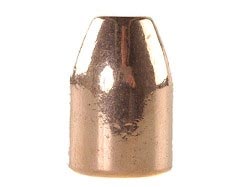
|
This load is light enough to shoot all day, and is very accurate. This is a good load for first-time shooters of the big bore. Keep in mind that “light” is relative – even though it’s the easiest shooting load here, it is still roughly as powerful as a .44 Magnum load. Titegroup is a good powder for this application because it is not position sensitive. It burns at close to the same rate no matter where it is in the case; making it ideal for small charges in big cases. Be careful though – there’s probably room for a triple charge in the case, and that would be ugly.
There are a couple of things to keep in mind when using plated bullets:
- Don’t run them faster than 1200 fps.
- Don’t use a roll crimp because the bullets have no cannelure, and a roll crimp can cut through the “jacket”.
Here’s a cautionary tale:
I recently loaded some of these hot (about 1500 fps) and forgot to reset my crimp die from the roll crimp I was using on
some other bullets. I made ten rounds and took them to the range to try out. The last shot sounded a little “funny”.
When I opened the cylinder, I found a ring of copper jacket stuck in the forcing cone. One more shot, and it would have been
the end of that revolver. Go easy with plated bullets.
|
The “Nuclear” Load (1650-1700 fps from the 8-3/8” barrel)
|
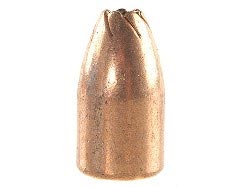
|
This load throws an amazing fireball. When fired from a 4” barrel, the concussion from this load is like getting punched in the face. Recoil is significant.
|
The Fast Load (2000-2050 fps from an 8-3/4” barrel)
|
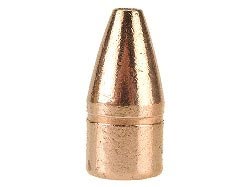
|
Don’t try this at home unless you’re going to use a vise and 300’ of twine. These rounds were expensive, but I wanted to crack the 2000 fps mark. I used new Hornady brass and CCI magnum primers (because they’re thicker even than the CCI large rifle primers) and worked up to this very slowly. Seriously, don’t even think about trying this unless you know how to look for (and measure) pressure signs. Don’t bother to look for flattened primers either, because these CCI magnum primers don’t flatten. I mic’ed the wall thickness of the case (before and after) at various places along the inside of the case to minimize the chances of blowing myself up as I worked up the load. If you don't know how to do this, don't try this load.
This load chrono’ed at 2300 FPS out of my H&R HandiRifle. Because of the hard/thick primers, I got frequent failures-to-fire (light strikes) in the HandiRifle, but not in the S&W revolver.
|
12 Gauge Slug Duplication Load (about 1300 fps out of a 4” barrel)
|
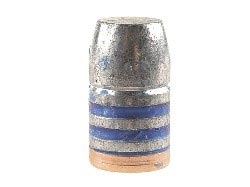
|
I wanted to duplicate a 12 gauge slug (1 oz at 1300fps) and this is what I came up with. This is a max load, so work up to it slowly. The recoil is deceptive; at first it’s not bad, but after a few rounds, the snappiness of the fast powder gets to you - and when I say “gets to you”, I mean “splits your hand open and makes you bleed enough to make the grips slippery”. This load caused me to buy a shooting glove. The next time I load these, I'll use H110, W296, or Lil’ Gun.
|
The "Hammer" (1350 fps out of an 8-3/8” barrel)
|
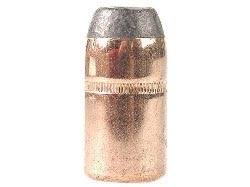
|
This is not a compressed load, but it is damn near compressed. These bullets are huge, and the recoil is humbling. When you shoot these one-handed out of an 8-3/8” barrel, the gun almost twists out of your hand. The torque is astounding.
|
Tyrannosaurus Thumpers (1150 fps w/8-3/8” barrel)
|
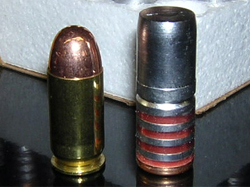
|
These things are huge. The picture on the right shows one of the bullets next to a loaded .45 ACP cartridge. The recoil really hurts. I once fired 50 of these in one day and my wrist hurt for a week. Think about it - it's 1/10th of a pound of lead moving at supersonic speed. The WC820 powder is a bit faster than H110/W296 or Lil' Gun and the charge fills virtually all of the available case capacity. These rounds aren't flashy or particularly loud, but they push you around. With my revolver sighted in for the "Nuclear" loads above, these rounds shot 16" above POA at 40 yards. Recoil will do that.
NOTE: Even with a strong roll crimp, I end up loading these only one or two at a time in my revolver. The recoil is so severe that if you load five rounds into the cylinder, the bullets in the remaining chambers will jump the crimp and lock up the cylinder after the 2nd round. This happens no matter how much crimp I put on them.
Loading the .460 S&W Magnum
Possibly because it is newer, I’ve found components and data hard to come by. You’ll notice that for both this and the .500, I use mostly Hodgdon powder. This is because they have a great set of load data available for free on their website. They did the work, and I’m going to reward them with my business.
Because of the extreme velocity of this round, there are only two bullet types that I’d trust for full power loads - these are the
Barnes solids and the Hornady XTP Mags. According to the manufacturers, regular jacketed pistol bullets shouldn’t be loaded
to run much faster than 1700 fps (1500 fps for gas checked lead). Even the starting loads for H110, W296, and Lil’ Gun are
above that velocity! Here’s two loads that are about the same in terms of performance:
-and-
|
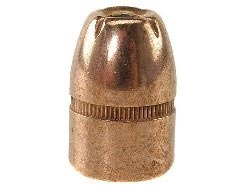
|
Both of these run faster than 2000 fps, and are both very accurate and flat-shooting. My best group was with the first (H110) load. Shooting with a 4X scope, from a Caldwell rest, I was able to make a group that looked like a 1.5” Chrysler logo on the bullseye at 100 yards.
Plinking Loads for the .460 S&W Magnum
I wrote this before:
Because the .460 can fire .45 Schofield, .45 Colt and .454 Casull, I don’t bother trying to download the .460 cartridge. It’s cheaper just to buy .45 Colt...
Well, I've changed my tune because I hate poor accuracy and extra cleaning.
Let me explain...
Most everybody knows that you can get sticky extraction in a .357 Magnum revolver if you fire .357 Mag rounds after firing a bunch of .38s. This is because the .38 case is shorter than the .357 Magnum by about .140", and you get a ring of crud built up in the last .140” of freebore within the chamber. When the .357 cases expand into the crud, they get hard to extract.
This effect is an order of magnitude worse with the .460 Magnum. The .460 case is 1.79” long. The amount of freebore for the lesser calibers is .410” with the .454 Casull, .510” with the .45 Colt, and .695" with the .45 Schofield! That’s three to five times more freebore difference when compared to the .38/.357 - with a larger diameter case (therefore more surface area). If you fire .45 Schofields, then .460 Magnums without cleaning in between, you’ll need to remove the cylinder and drive the cases out with a dowel.
That much freebore also causes barrel leading and poor accuracy. When firing .45 Colt rounds, the bullet leaves the case and travels through more than 1/2" of freebore before it finally seals up at the end of the cylinder. During this time, hot gases erode the sides of the bullet and deposit molten lead inside the cylinder and in and around the forcing cone. It's just not worth it.
Here's a better way:
Plinking Loads (950 fps from a 5" barrel)
|
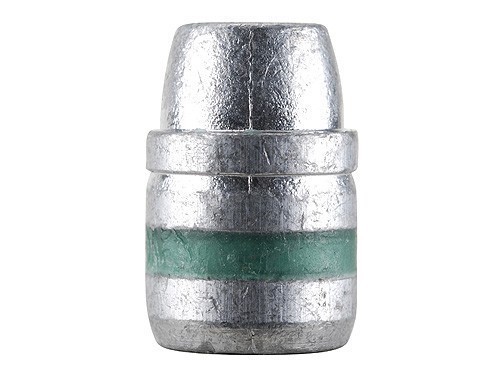
|
These loads are very light recoiling and tremendously accurate. Firing from a machine rest, these rounds go into one hole at 20 yards. Trailboss is a light and "fluffy" powder (a one pound sized can only holds 9oz of powder). That 13.7 grain charge fills the case to capacity, resulting in very consistent velocity from shot-to-shot. These rounds shoot pretty clean and do not lead the barrel.
You won't find this plinking load in any load manual - I got it from Hodgdon over the phone (Hodgdon owns IMR). The max load is a powder charge that fills the case up to the base of the bullet (you should not compress Trailboss); the minimum load is 70% of the max (9.6 grains). I've found that the max load provides the most consistent velocity and the best accuracy. I've tried this load with a variety of inexpensive 255gr lead bullets and it works equally well with all of them.